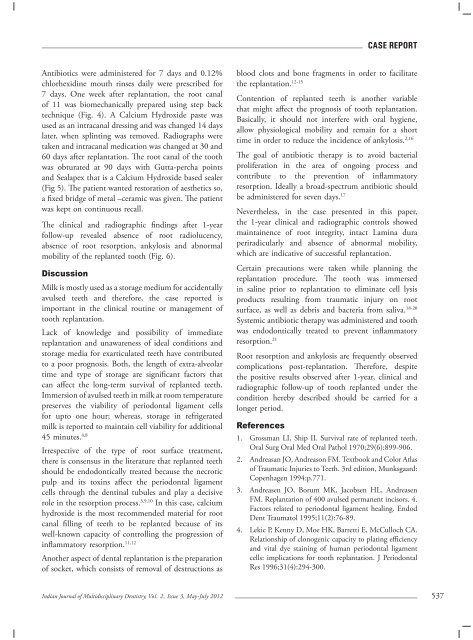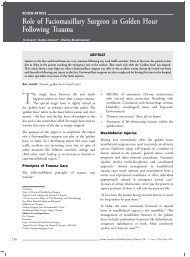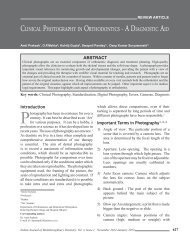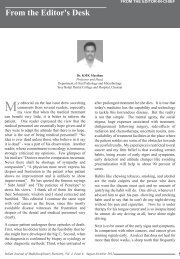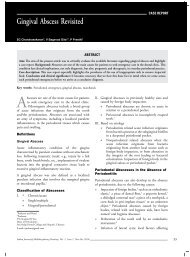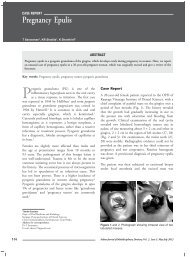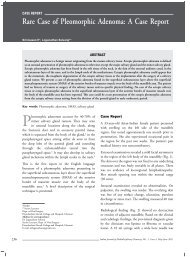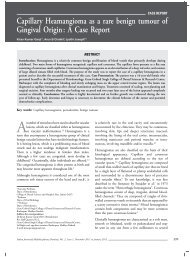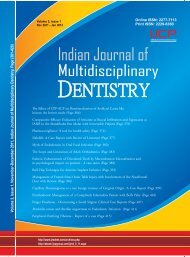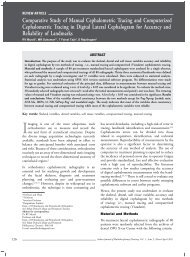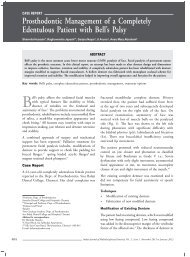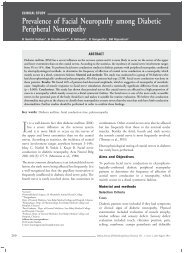Volume 2 - Issue 3 (May-Jul)
Volume 2 - Issue 3 (May-Jul)
Volume 2 - Issue 3 (May-Jul)
Create successful ePaper yourself
Turn your PDF publications into a flip-book with our unique Google optimized e-Paper software.
Case Report<br />
Antibiotics were administered for 7 days and 0.12%<br />
chlorhexidine mouth rinses daily were prescribed for<br />
7 days. One week after replantation, the root canal<br />
of 11 was biomechanically prepared using step back<br />
technique (Fig. 4). A Calcium Hydroxide paste was<br />
used as an intracanal dressing and was changed 14 days<br />
later, when splinting was removed. Radiographs were<br />
taken and intracanal medication was changed at 30 and<br />
60 days after replantation. The root canal of the tooth<br />
was obturated at 90 days with Gutta-percha points<br />
and Sealapex that is a Calcium Hydroxide based sealer<br />
(Fig 5). The patient wanted restoration of aesthetics so,<br />
a fixed bridge of metal –ceramic was given. The patient<br />
was kept on continuous recall.<br />
The clinical and radiographic findings after 1-year<br />
follow-up revealed absence of root radiolucency,<br />
absence of root resorption, ankylosis and abnormal<br />
mobility of the replanted tooth (Fig. 6).<br />
Discussion<br />
Milk is mostly used as a storage medium for accidentally<br />
avulsed teeth and therefore, the case reported is<br />
important in the clinical routine or management of<br />
tooth replantation.<br />
Lack of knowledge and possibility of immediate<br />
replantation and unawareness of ideal conditions and<br />
storage media for exarticulated teeth have contributed<br />
to a poor prognosis. Both, the length of extra-alveolar<br />
time and type of storage are significant factors that<br />
can affect the long-term survival of replanted teeth.<br />
Immersion of avulsed teeth in milk at room temperature<br />
preserves the viability of periodontal ligament cells<br />
for upto one hour; whereas, storage in refrigerated<br />
milk is reported to maintain cell viability for additional<br />
45 minutes. 4,8<br />
Irrespective of the type of root surface treatment,<br />
there is consensus in the literature that replanted teeth<br />
should be endodontically treated because the necrotic<br />
pulp and its toxins affect the periodontal ligament<br />
cells through the dentinal tubules and play a decisive<br />
role in the resorption process. 3,9,10 In this case, calcium<br />
hydroxide is the most recommended material for root<br />
canal filling of teeth to be replanted because of its<br />
well-known capacity of controlling the progression of<br />
inflammatory resorption. 11,12<br />
Another aspect of dental replantation is the preparation<br />
of socket, which consists of removal of destructions as<br />
blood clots and bone fragments in order to facilitate<br />
the replantation. 12-15<br />
Contention of replanted teeth is another variable<br />
that might affect the prognosis of tooth replantation.<br />
Basically, it should not interfere with oral hygiene,<br />
allow physiological mobility and remain for a short<br />
time in order to reduce the incidence of ankylosis. 2,16<br />
The goal of antibiotic therapy is to avoid bacterial<br />
proliferation in the area of ongoing process and<br />
contribute to the prevention of inflammatory<br />
resorption. Ideally a broad-spectrum antibiotic should<br />
be administered for seven days. 17<br />
Nevertheless, in the case presented in this paper,<br />
the 1-year clinical and radiographic controls showed<br />
maintainence of root integrity, intact Lamina dura<br />
periradicularly and absence of abnormal mobility,<br />
which are indicative of successful replantation.<br />
Certain precautions were taken while planning the<br />
replantation procedure. The tooth was immersed<br />
in saline prior to replantation to eliminate cell lysis<br />
products resulting from traumatic injury on root<br />
surface, as well as debris and bacteria from saliva. 18-20<br />
Systemic antibiotic therapy was administered and tooth<br />
was endodontically treated to prevent inflammatory<br />
resorption. 21<br />
Root resorption and ankylosis are frequently observed<br />
complications post-replantation. Therefore, despite<br />
the positive results observed after 1-year, clinical and<br />
radiographic follow-up of tooth replanted under the<br />
condition hereby described should be carried for a<br />
longer period.<br />
References<br />
1.<br />
2.<br />
3.<br />
4.<br />
Grossman LI, Ship II. Survival rate of replanted teeth.<br />
Oral Surg Oral Med Oral Pathol 1970;29(6):899-906.<br />
Andreasan JO, Andreason FM. Textbook and Color Atlas<br />
of Traumatic Injuries to Teeth. 3rd edition, Munksgaard:<br />
Copenhagen 1994:p.771.<br />
Andreasen JO, Borum MK, Jacobsen HL, Andreasen<br />
FM. Replantation of 400 avulsed permanent incisors. 4.<br />
Factors related to periodontal ligament healing. Endod<br />
Dent Traumatol 1995;11(2):76-89.<br />
Lekic P, Kenny D, Moe HK, Barretti E, McCulloch CA.<br />
Relationship of clonogenic capacity to plating efficiency<br />
and vital dye staining of human periodontal ligament<br />
cells: implications for tooth replantation. J Periodontal<br />
Res 1996;31(4):294-300.<br />
Indian Journal of Multidisciplinary Dentistry, Vol. 2, <strong>Issue</strong> 3, <strong>May</strong>-<strong>Jul</strong>y 2012<br />
537


